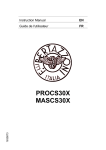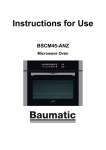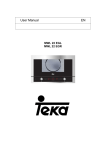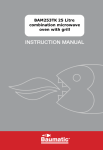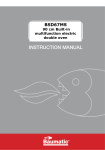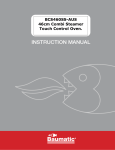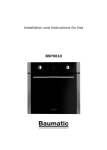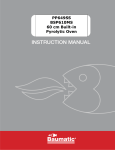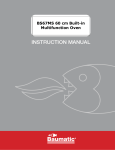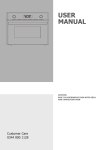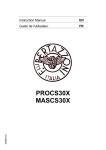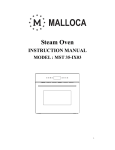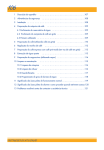Download Manual - Baumatic
Transcript
Installation & Instructions for Use BSCS45-ANZ Combi Steam Oven EN Contents Safety Instructions ............................................................................................................................. 2 Installation instructions ..................................................................................................................... 5 Description of your oven.................................................................................................................... 6 Basic settings ..................................................................................................................................... 8 Basic functions ................................................................................................................................. 11 Auto Cooking functions ................................................................................................................... 14 Water feeding .................................................................................................................................... 16 When the oven is working................................................................................................................ 17 Usage, Tables and Tips .................................................................................................................... 18 Care and maintenance ..................................................................................................................... 27 Oven Cleaning................................................................................................................................... 31 What should I do if the oven doesn’t work? ................................................................................... 32 Technical characteristics ................................................................................................................. 33 Installation ......................................................................................................................................... 35 Dear Customer: Before going any further, we want to thank you for choosing our product. We are sure that this modern, functional and practical oven, manufactured with top quality materials, will fully meet your expectations. We ask you to read the instructions in this booklet very carefully as this will allow you to get the best results from using your oven. Always keep the instruction manual handy. If you pass the oven to someone else give them the manual as well! IMPORTANT SAFETY INSTRUCTIONS. READ CAREFULLY AND KEEP FOR FUTURE REFERENCE. 1 EN Safety Instructions • Warning! Do not leave the oven unsupervised. • Warning! If you see smoke or fire, keep the door closed in order to smother the flames. Switch off the oven and take the plug out of the socket or cut off the oven power supply. • This appliance is not intended for use by persons (including children) with reduced physical, sensory or mental capabilities, or lack of experience and knowledge, unless they have been given supervision or instruction concerning use of the appliance by a person responsible for their safety. Children shall not play with the appliance. Cleaning and user maintenance shall not be made by children without supervision. • Children must be supervised to ensure that they do not play with the appliance. Use the safety locks. Only supervised children or adequately instructed children shall use the oven. • Warning! During use the appliance becomes very hot. Care should be taken to avoid touching heating elements inside the oven. RISK OF BURNS! • Warning! Accessible parts may become hot during use. To avoid burns, young children should be kept away. • Warning! When opening the door during or upon completion of the cooking cycle, be careful of the flow of hot air and/or steam and water drops coming out of the cooking chamber. Step back or to the side to avoid burns. • Warning! Make sure you never catch the power cables of other electrical appliances in the hot door or the oven. The cable insulation may melt. Danger of short-circuiting! This oven is exclusively for domestic use! The appliance is designed for use in the home for preparing food. No liability is assumed for any damage caused by improper or incorrect use. 2 EN Safety Instructions Avoid damaging the oven or other dangerous situations by following these instructions: • Do not cover or obstruct the ventilation openings. • Do not keep any inflammable object inside the oven as it may burn if the oven is switched on. • Do not use the oven as a pantry. • Do not pour spirits (e.g. brandy, whisky, schnapps, etc.) over hot food. Danger of explosion! • Accessories such as wire racks and trays, etc. get hot in the cooking space. Always wear protective gloves or use oven cloths. • To avoid being burnt, always use oven gloves for handling dishes and containers and touching the oven. • Do not lean or sit on the open oven door. This may damage the oven, especially in the hinge zone. The door can bear a maximum weight of 8 kg. • The racks can bear a maximum load of 8 kg. To avoid damaging the oven, do not exceed this load. Cleaning: • The appliance will remain hot for some time after it is switched off and cool down only slowly to room temperature. Please allow sufficient time for the appliance to cool down before, for instance, cleaning it. • Do not use harsh abrasive cleaners or sharp metal scrapers to clean the oven door glass since they can scratch the surface, which may result in shattering of the glass. • Do not use high pressure or steam jet cleaning appliances. • Please follow the instructions regarding cleaning in the section “Oven Cleaning and Maintenance”. . 3 EN Safety Instructions Repairs: • If the power cable is damaged it should be substituted by the manufacturer, authorized agents or technicians qualified for this task in order to avoid dangerous situations. Furthermore, special tools are required for this task. • Repair and maintenance work, especially of current carrying parts, can only be carried out by technicians authorized by the manufacturer. Warning: If the door or door seals are damaged, do not operate the oven until it has be repaired by a competent person. It is hazardous for anyone other than a competent person to carry out any service or repair operation that involves the removal of a cover which gives protection against exposure to microwave energy. Warning: Liquids and foods must not be heated in sealed containers. 4 EN Installation instructions Before installation After installation Check that the input voltage indicated on the characteristics plate is the same as the voltage of the power outlet you are going to use. The oven is equipped with a power cable and a plug for single phase (household) current, 230-240V ~ 50Hz. Open the oven door and take out all the accessories and remove the packing material. If the oven is to be installed on a permanent basis it must be installed by a qualified technician. In such a case, the oven should be connected to a circuit with an all-pole circuit breaker with a minimum separation of 3 mm between contacts. Warning! The front surface of the oven may be covered in a protective film. Before using the oven for the first time, carefully remove this film, starting on the inside. Make sure that the oven is not damaged in any way. Check that the oven door closes correctly and that the interior of the door and the front of the oven opening are not damaged. If you find any damage contact our Customer Care Centre on the number supplied on the back cover of this handbook. DO NOT USE THE OVEN if the power cable or the plug is damaged, if the oven does not function correctly or if it has been damaged or dropped. Contact our Customer Care Centre on the number supplied on the back cover of this handbook. WARNING: THE OVEN MUST BE EARTHED. The manufacturer and retailers do not accept responsibility for any damage that may be caused to persons, animals or property if these installation instructions are not observed. The oven only functions when the door is closed correctly. Before the first use, clean the inside of the oven and the accessories, following the cleaning instructions given in the “Oven cleaning” section. Put the oven on a flat and stable surface. The oven must not be installed close to any sources of heat, radios or televisions. During installation, make sure that the power cable does not come into contact with any moisture or objects with sharp edges and the back of the oven. High temperatures can damage the cable. Warning: after the oven is installed you must make sure you can access the plug. During installation, follow the instructions supplied separately. 5 EN Description of your oven 5 4 7 3 6 9 2 8 1 1. – Door window glass 2. – Safety catches 3. – Water tank 4. – Control panel b a 1 c 13:30 120 1 2 2 a. – Timer light b. – Function lights c. – “+”and “–” keys d. – Start and Stop keys 6 5. – Baking tray 6. – Perforated baking tray 7. – Shelf guides 8. – Rack 9. – Lamp bulb 3 4 5 6 d 1. – Water Level / Descale display and key 2. – Water Level / Descale lights 3. – Temperature display and key 4. – Temperature light 5. – Clock / Duration display and key 6. – Clock / Duration lights EN Description of your oven Description of Functions Symbol Function Foods Steam Cooking all sorts of vegetables, rice, cereals and meat. Extracting juice from berries. Simultaneous defrosting and cooking of vegetables. Hot Air Roasting and baking. Cooking meals with hot damp circulating air. Hot Air + Steam Cooking potatoes, rice. Moist garnishing. Grill Grill + Hot Air Grilling meat and fish Grilling Potatoes – deep frozen, defrosting and roasting. Grilling food, Roasting and Baking Regenerating & Regenerating plate dishes and ready-made meals. Sterilising Sterilising/boiling down fruit. 7 EN Basic settings Initial Settings After your steam oven is first plugged in or after a power failure, the clock display will flash to indicate that the time shown is not correct. To set the clock and the water hardness parameter value proceed as described in the following chapters. The oven will not operate until the clock, the water hardness parameter and the Calibration is set. Setting the clock 2,4 13:30 1,3,5 To set the clock, proceed as follows: 1. Press the Clock key. The hour numbers will start to flash (not necessary if your Steam oven is first plugged in or after a power failure). 2. Press the “+” and “–” to set the correct hour value. 3. Press again the Clock key to set the minutes. The minute numbers will start to flash. 4. Press the “+” and “–” to set the correct minute value. 5. To finish, press the Clock key again. Hiding/Displaying the Clock If the clock display disturbs you, you can hide it by pressing the Clock setting key for 3 seconds. The dots that separate the hours and minutes will flash but the rest of the clock display will be hidden. If you want to see the clock display again, press the Clock setting key again for 3 seconds. Water Hardness setting The appliance features a system that automatically indicates when it is time to descale. 1. Press the Descale key. The hardness number will start to flash on the Descale display (not necessary if your Steam oven is first plugged in or after a power failure). The system can be optimised for households with very soft water (also through using a water softening appliance) and very hard water, by changing the user settings to the relevant range of water hardness (see table below). 2. Press the “+” and “–” to set the correct water hardness parameter value, according to the below table. To set the water hardness parameter, proceed as follows: 3. Press the Descale key to set the parameter. The Descale display switches off. 8 Water hardness English deg. French deg. [°eH] [°dF] Type Ca + Mg (ppm) German deg. [°dH] Display Soft water 0 to 150 0 to 11 0 to 15 0 to 8 1 Medium water 151 to 350 12 to 25 16 to 35 9 to 20 2 Hard water 501 to 500 26 to 35 36 to 50 21 to 28 3 EN Basic settings Water level calibration ---After setting the water hardness, appears in the Display and the water level light shines. Please take the Water tank completely off. Wait until the display and the Water tank light disappears. Safety blocking The oven functioning can be blocked (for example, to stop it being used by children). SAFE 1,2 1. To block the oven, press the Stop key for 3 seconds. You will hear a sound signal and the display will show the word “SAFE”. The oven is blocked in this state and cannot be used. 2. To unblock the oven, press the Stop key again for 3 seconds. You will hear a sound signal and the display will show the time again. 9 EN Basic settings Timer The timer functions like an egg timer. It can be used at any time and independently of all other functions. 1,3 To set the Timer proceed as follows: 1. Press the Timer key. The function key lights up and the Clock display starts blinking. 2. Press the “+” and “–” keys to set the Timer value. 3. Press the Timer key to validate. The Timer will start counting-down. When the set time has elapsed the oven will emit three beeps that will be repeated every 30 seconds or until the Timer or Stop keys are pressed. 10 0:00 2 While the Timer is running the Timer light is on. The display and lights show the following: 1. If there is no function running, the Clock display shows the Timer counting-down. 2. If there is an active function, the displays and lights show the normal function parameters. To check the Timer’s remaining time press the Timer key. The Clock display will briefly show the Timer and resume the function indications after 10 seconds or once the Timer key is pressed again. EN Basic functions Steam function Use this function to cook all sorts of vegetables, rice, cereals and meat. It is also suitable for extracting juice from berries and for simultaneous defrosting and cooking of vegetables. 1 100 2 20:00 4 1. Press the Steam Function key. The function key lights up. 2. Press the Temperature key to set the desired value. The respective light will start to flash. If you do not press this key, the oven operates at 100 ºC. 3. To change the Temperature press the “+” and “–” keys. 3,5 6 4. Press the Duration key to change the operating time. The respective light will start to flash. This setting is optional. Please jump to point 6 if you don’t want to set duration. 5. Select the operating time you want by pressing the “+” and “–” (for example, to 20 minutes). 6. Press the Start key. The oven will start to operate. Grill Use this function to brown the top of food quickly. 1 3 15:00 2 4 1. Press the function key Grill. The function key lights up. 3. Press key “-” and “+”, to change the function time (e.g. 15 minutes). 2. Press the Time Selection key to change the operating time. The correspondent light will start to flash. 4. Press the Start key. The oven will start to operate. 11 EN Basic functions Hot air Use this function to bake and roast. 1 2 3,5 10:00 160 6 4 1. Press the function key Hot air. The function key lights up. 4. Press the Time Selection key to change the operating time. The respective light will start to flash. 2. Press the temperature key to change the temperature. The respective light will flash. If you do not press this key, the oven operates at 160ºC. 5. Press key “-” and “+”, to change the function time (e.g. 12 minutes). 6. Press the Start key. The oven will start to operate. 3. To change the temperature press key “-” and “+”. Steam with Hot-Air Use this function for crispy roast meat, fish, poultry or French fries 1 600 2 1. Press the function key Steam with Hot-Air. The function key lights up. 2. Press the temperature key to change the temperature. The respective light will flash. 3. To change the temperature press key “-” and “+”. 12 3,5 12:00 4 6 4. Press the Time Selection key to change the operating time. The respective light will start to flash 5. Press key “-” and “+”, to change the function time (e.g. 12 minutes). 6. Press the Start key. The oven will start to operate. EN Basic functions Grill with Fan Use this function for crispy roast meat, fish, poultry or French fries 1 12:00 160 2 4 1. Press the function key Grill with Fan. The function key lights up. 2. Press the temperature key to change the temperature. The respective light will flash. If you do not press this key, the oven operates at 160 ºC. 3. To change the temperature press key “-” and “+”. 3,5 6 4. Press the Time Selection key to change the operating time. The respective light will start to flash 5. Press key “-” and “+”, to change the function time (e.g. 12 minutes). 6. Press the Start key. The oven will start to operate. 13 EN Auto Cooking functions Regenerating & Sterilising Use this function to regenerate plate dishes and ready-made meals as well as to sterilise and boil down fruit. 1 3 13:00 r1 4 2 1. Press the Regenerating Function key. The function key lights up. 3. To change the Programme press the “+” and “–” keys, e.g. “r 01” (see following table). 4. Press the Start key. The oven will start to operate. 2. Press the Clock / Duration display and key to change the food type. The respective light will start to flash. Programme Type of Food Temperature ºC Time (min) Instructions r 1 Plate dishes 100°C 13 Remove lid from container r 2 Ready-made meals / frozen 100°C 18 and put on rack. r 3 Beans 100°C 35 Sterilising: r 4 Cherries 80°C 35 The times and temperatures refer to 1L preserving jars. r 5 Plums 90°C 35 Auto cooking function A Use this function cook the vegetables described in the table below. 1 A1 20:00 2 1. Press the Auto cooking function key. The function key lights up. 2. Press the Clock / Duration display and key selection key to change the food type. The respective light will flash. 3 4 3. Press “+” and “–” keys to change the programme, e.g. “A 1” (see following table). 4. Press the Start key. The oven will start to operate. The following table shows the Cooking Vegetables programmes, indicating weight intervals, and cooking and standing times (in order to ensure the food is of a uniform temperature). 14 Programme Type of Vegetable Temperature ºC Time (min) A1 Broccoli / florets 100°C 20 A2 Cauliflower / florets 100°C 25 A3 Potatoes / pieces 100°C 25 A4 Snow peas 100°C 15 A5 Asparagus 100°C 25 EN Auto Cooking functions Auto cooking function B Use this function cook the fish types described in the table below. 1 b 1 25:00 3 4 2 1. Press the Cooking Fish function key. The function key lights up. 2. Press the Clock / Duration display and key selection key to change the food type. The respective light will flash. 3. Press “+” and “–” keys to change the programme, e.g. “b 1” (see following table). 4. Press the Start key. The oven will start to operate. The following table shows the Cooking Fish programmes, indicating weight intervals, and cooking and standing times (in order to ensure the food is of a uniform temperature). Programme Type of Fish Temperature ºC Time (min) b 1 Trout 80°C 25 b 2 Shrimp 90°C 15 b 3 Fish filet 80°C 18 b 4 Mussels 100°C 25 b 5 Lobster 100°C 30 Auto cooking function C Use this function cook the meat types described in the table below. 1 C1 30:00 3 4 2 1. Press the Cooking Meat function key. The function key lights up. 2. Press the Clock / Duration display and key selection key to change the food type. The respective light will flash. 4. Press the Start key. The oven will start to operate. The following table shows the Cooking Meat programmes, indicating weight intervals, and cooking and standing times (in order to ensure the food is of a uniform temperature). 3. Press “+” and “–” keys to change the programme, e.g. “C 1” (see following table). Programme Type of Meat Temperature ºC Time (min) C 1 Chicken breast 100 ºC 30 C 2 Smoked pork loin / pieces 100 ºC 45 C 3 Turkey escalope 100 ºC 20 C 4 Pork filet, whole 100 ºC 25 C 5 Vienna sausages 90 ºC 15 15 EN Water feeding Filling the water tank Water tank message All functions require the water tank to be full. When the water tank is removed or misplaced, the Water Level display shows the message “RES”. Fill the water tank up to the “MAX” mark with cold, fresh drinking water and introduce it into the slot located above the cavity (approximately 1L). If the indication “rES” appears, it means that the water tank was not properly inserted. Res To clear the message, correctly insert the water tank. Emptying the water tank Water level indication The water tank level is indicated in four levels: “-L0-“ 0%-20% “-L1-“20%-60% “-L2-“60%-100% These indications are shown in the leftmost display. -L2Remark: To fill up take the water tank completely off. Wait approximately > 20seconds before reinstate the full water tank. When the appliance is switched off, the residual water is pumped back into the water tank. While the water is being pumped the display shows “PUMP”. This message stays on until the temperature of the water reaches 75º C before it can be pumped back to the water tank. Warning: the water in the tank may be hot. Danger of burns! After the water is pumped back to the water tank, the display will show the message “DEP” requiring the following actions: 1. Remove and empty the water tank. 2. Dry the water tank and introduce it back into the slot located above the cavity. Clean and dry the cooking space. 3. Leave the appliance door open so that the cooking space can cool down and dry completely. The contents of the water tank normally suffice for one cooking session of 50-60 minutes. IMPORTANT NOTE: It is advisable to remove the water tank and empty it after a cooking cycle. This prevents the formation of bacteria and limestone inside the appliance. If, however, the water tank needs to be refilled this is signalled by the message “- L0 -” meaning that the water tank is empty. If the water tank has not been removed from the oven and a new cooking cycle is started, the oven displays the warning “DEP”. Refilling the water Warning! Only fill the water tank up to a maximum of 0.5 litres to ensure that the water does not overflow when it is pumped back to the water tank. RISK OF OVERFLOW. 16 This warning can be cleared by pressing the Stop key and proceed with the new cooking cycle without removing and emptying the water tank. EN When the oven is working... Interrupting a cooking cycle Cancelling a cooking cycle You can stop the cooking process at any time by pressing the Stop key once. If you wish to cancel the cooking process, press the Stop key twice. The oven incorporates a steam-reduction function that is activated when the Stop key is pressed to gradually release the steam from the cavity, so that there is no sudden rush of steam when the appliance door is opened. You will then hear 3 beeps and the message “End” will appear on the display. This function takes around 3 minutes and during it the display shows the word “VAP”. Warning! When opening the door during or upon completion of the cooking cycle, be careful of the flow of hot air and/or steam coming out of the cooking chamber. Step back or to the side to avoid burns. At this point: • The steam generation is interrupted. • The cavity walls and the water tank are still very hot. Danger of burning! • The timer stops and the display shows the remaining operating time (if this has been set). If you wish, at this point you can: 1. Turn or stir the food to ensure it will be evenly cooked. 2. Change the cooking parameters. To restart the process, close the door and press the Start key. Altering parameters The operating parameters (time and temperature) can be altered when the oven is operating or when the cooking process has been interrupted by proceeding as follows: 1. To alter the time, press “+” and “–” keys. The new time defined is immediately valid. 2. To alter the temperature, press the Temperature Selection key and the display and respective light start to flash. Alter the parameter by pressing the “+” and “–” keys and confirm by pressing the Temperature Selection key again. End of a cooking cycle At the end of the set duration or when you press the Stop key to finish the cooking cycle the oven starts the steam-reduction function. This function gradually releases the steam from the cavity, so that there is no sudden rush of steam when the appliance door is opened. This function takes around 3 minutes and during it the display shows the word “VAP”. At the end of this process you will hear three beeps and the display will show the word “End”. Warning! When opening the door during or upon completion of the cooking cycle, be careful of the flow of hot air and/or steam coming out of the cooking chamber. Step back or to the side to avoid burns. The beeps are repeated every 30 seconds until the door is opened or the Stop key is pressed. The cooling fan can continue to run for a certain length of time after the appliance has been switched off. This is a normal function that is meant to reduce the temperature inside the oven. When the display shows the word “DEP”, this means that the water was pumped and that the water tank can be removed. Remove the water tank and dry it thoroughly. Let the cooking space cool down for a moment and then clean and dry it with a cloth. The door should be left open for some time so that the appliance can dry completely. Residual water in the oven To reduce the residual water in the oven, it is recommended to insert a tray in the bottom rack level. The condensation released from the food begins to drip on the tray. The remaining residual water can be easily dried with a cloth. 17 EN Usage, tables and tips Use of accessories The perforated container is suitable for cooking fresh or deep frozen vegetables, meat and poultry. In this case it is important that the nonperforated container is introduced into the first level. This way, dripping liquids are collected and the appliance does not get dirty. The perforated container with the food should be inserted into the second level. The rack is used when cooking with small containers, as for example, dessert bowls and to regenerate plate dishes. For more precise information refer to the tables. The suggested times and temperatures are guideline values. The actual cooking time can vary according to the type and quality of the foods. The non-perforated container is used to steam sensitive foods, e.g. compotes and dumplings. To remove the rack, lift it upwards slightly at the front when the safety notches connect with the sides of the oven (see illustration). We recommend using the rack together with the baking tray when cooking items on the rack which might drip. 18 EN Cooking with Steam Steam cooking - Fish Fish Quantity Temperature ºC Time min. Container 800-1200 g 80 30-40 Perforated Level 2 4 x 250 g 80 20-25 Perforated 2 Salmon filet 500-1000 g 80 15-25 Perforated 2 Salmon trout 1000-1200 g 80 25-35 Perforated 1/2 King prawns 500-1000 g 80 15-20 Perforated 2 Green-shell mussel 1000-1500 g 100 25-35 Perforated 2 Halibut filet 500-1000 g 80 20-25 Perforated 2 Cockles 500-1000 g 100 10-20 Perforated 2 Lobster 800-1200 g 100 25-30 Perforated 1/2 Cod filet 1000-1200 g 80 20-25 Perforated 2 Blue mussel 1000-1200 g 100 15-25 Perforated 2 Lake trout 4 x 250 g 80 25-30 Perforated 2 Haddock 1000-1200 g 80 20-25 Perforated 2 Tuna filet 500-1000 g 80 15-20 Perforated 2 4 x 250 g 80 25-30 Perforated 2 Gilthead sea bream Trout Pike perch 19 EN Cooking with Steam Steam cooking - Meat Meat Quantity Temperature ºC Time min. Container Level Chicken leg 4-10 100 40-45 Perforated 2 Chicken breast 4-6 100 25-35 Perforated 2 Smoked pork loin 500g – 1000 g 100 40-50 Perforated 2 Turkey escalope 4-8 100 20-25 Perforated 2 Pork filet, whole 4-8 100 20-30 Perforated 2 80-100 10-15 Perforated 2 Temperature ºC Time min. Container Level Eggs in Glass 100 10-15 Rack 2 Eggs, hard 100 15 Rack 2 Eggs, soft 100 10-12 Rack 2 Sausages Steam cooking - Eggs Eggs Steam cooking - Side dishes Quantity Temperature ºC Time min. Container Level Pearl barley + Liquid 200g + 400 ml 100 30-35 Rack, glass bowl 2 Semolina + Liquid 200g + 300 ml 100 10-20 Rack, glass bowl 2 Lentils + Liquid 200g + 375 ml 100 20-50 Rack, glass bowl 2 Rice + Liquid 200g + 250 ml 100 25-40 Rack, glass bowl 2 Side dishes 20 EN Cooking with Steam Steam cooking - Vegetables Vegetables Eggplant/Aubergine Temperature ºC Time min. Container Level 100 15-20 Perforated 2 100 35-45 Perforated 2 in slices Beans Broccoli florets with stalk 100 25-30 Perforated 2 Broccoli florets without stalk 100 15-20 Perforated 2 Cauliflower florets 100 25-30 Perforated 2 Cauliflower whole head 100 40-45 Perforated 1 100 30-35 Perforated 2 Peas Fennel in stripes 100 15-20 Perforated 2 Fennel cut in half 100 20-30 Perforated 2 Potatoes with skin whole, very small 100 20-25 Perforated 2 Potatoes with skin whole, very big 100 45-50 Perforated 2 Potatoes without skin in pieces 100 20-25 Perforated 2 Turnip in sticks 100 20-25 Perforated 2 100 15-20 Perforated 2 100 25-30 Perforated 2 100 50-60 Perforated 2 100 12-15 Perforated 2 100 12-15 Perforated 2 Snow peas Carrots in slices Corn cobs Bell peppers in stripes Hot pepper Mushrooms in quarters 100 12-15 Perforated 2 Leeks in slices 100 10-12 Perforated 2 100 25-35 Perforated 2 100 15-20 Perforated 2 Asparagus 100 20-35 Perforated 2 Spinach 100 12-15 Perforated 2 Celery stalks 100 25-30 Perforated 2 100 12-18 Perforated 2 Brussels sprouts Celery in stripes Courgette in slices Steam cooking - Dumplings Temperature ºC Time min. Container Level Sweet dumpling 100 20-30 Not perforated 2 Sweet yeast dumpling 100 15-20 Not perforated 2 Yeast dumpling 100 15-25 Not perforated 2 Bread dumpling 100 20-25 Not perforated 2 Napkin dumpling 100 25-30 Not perforated 2 Dumplings 21 EN Cooking with Steam Steam cooking - Desserts Desserts Quantity Temperature ºC Time min. Container Level Stewed apples 500-1500 g 100 15-25 Not perforated 2 Stewed pears 500-1500 g 100 25-30 Not perforated 2 Crème brûlée 80 20-25 Rack - bowl 2 Crème caramel 80 25-30 Rack - bowl 2 Yogurt 40 4-6 hrs. Rack - bowl 2 100 15-20 Not perforated 2 Stewed peaches 500-1500 g Steam cooking - Fruit (Sterilising/Boiling down) Quantity Temperature ºC Time min. Container Level Pears 4-6 1l glasses 100 30-35 Rack 1 Cherries 4-6 1l glasses 80 30-35 Rack 1 Peaches 4-6 1l glasses 80 30-35 Rack 1 Plums 4-6 1l glasses 80 30-35 Rack 1 Quantity Temperature ºC Time min. Container Level Plate dishes 1-2 100 12-15 Rack 2 Plate dishes 3-4 100 15-20 Rack 2 100 15-20 Rack 2 Temperature ºC Time min. Container Level 100 10-12 Perforated 2 1000-2000 g 100 12-16 Perforated 2 10-20 100 12-15 Perforated 2 2000-2500 g 100 30-45 Perforated 1 80 12 Rack 2 Fruit Steam cooking - Regenerate Warming-up Ready-made meals Steam cooking - Blanch Vegetables Quantity e.g. Beans, Leek Curly Kale Savoy cabbage White cabbage, whole Tomatoes, peeled 22 EN Cooking with Steam Steam cooking - Defrost Vegetables / Side dish Broccoli Temperature ºC Time min. Container Level 100 15-20 Perforated 2 100 15-20 Perforated 2 florets with stalk Mixed vegetables Spinach leaves portions 100 10-15 Not perforated 2 Cauliflower florets 100 15-20 Perforated 2 100 15-25 Perforated 2 Peas Curly kale bigger portion 100 25-35 Not perforated 2 Carrots in slices 100 15-20 Perforated 2 Brussels sprouts 100 20-25 Perforated 2 Asparagus 100 25-30 Perforated 2 Ready-made meals 100 as required Rack 2 Bread 100 10-25 Rack 2 Rice 100 15-25 Not perforated 2 Lentils 100 15-20 Not perforated 2 Noodles 100 15-20 Not perforated 2 Two level cooking Some suggestions: One example: Vegetables, potatoes and fish. When cooking with two levels the grill always belongs to the 2nd or 3rd level of insertion from the bottom to the top. Place the vegetables and potatoes in any suitable container on the rack inserted in the 2nd or 3rd level. This way the usual vessels of porcelain, Jena glass or of stainless steel can be put inside the oven. Insert the fish in the 1st level. The container of cooking perforated or not, will be inserted in the 1st level from the bottom. It can also be cooked with two grills. When using the perforated tray to cook fish, the non-perforated tray must be inserted in the bottom of the appliance to collect liquid dripping from the fish. This way the appliance is kept clean. Different cooking times are controlled this way: Time: Vegetables and potatoes 25-35 Min. Foods that need a longer cooking time should be placed in the upper area of the oven. Foods with a shorter cooking time should be placed on the 1st level. Time: Fish – depending on type – 15-25 Min. Select the longest cooking time. Because of the different levels the food is ready at the same time, without any over cooking. 23 EN Cooking with the grill For good results with the grill, use the grid iron supplied with the oven. Fit the grid iron in such a way that it doesn’t come into contact with the metal surfaces of the oven cavity since if it does there is a danger of electric arcing which may damage the oven. IMPORTANT POINTS: 1. When the grill is used for the first time there will be some smoke and a smell coming from the oils used during oven manufacture. 2. The oven door window becomes very hot when the grill is working. Keep children away. 3. When the grill is operating, the cavity walls and the grid iron become very hot. You should use oven gloves. Type of food Bass Sardines/gurnard Sausages Frozen hamburgers Spare rib (approx. 3 cm thick) Toast Toasted sandwiches Quantity (g) 800 6-8 fish. 6-8 units 3 units 400 4 units 2 units 5. Important! When food is to be grilled or cooked in containers you must check that the container in question is suitable for use. See the section on types of ovenware! 6. When the grill is used it is possible that some splashes of fat may go onto the elements and be burnt. This is a normal situation and does not mean there is any kind of operating fault. 7. After you have finished cooking, clean the interior and the accessories so that cooking remains do not become encrusted. Time (min.) Fish 18-24 15-20 Meat 22-26 18-20 25-30 Others 1½-3 5-10 Heat up the grill beforehand for 2 minutes. Unless indicated otherwise, use the grid iron. Place the grid on a bowl so that the water and the fat can drop. The times shown are merely indicative and can vary as a function of the composition and quantity of the food, as well as the final condition wished for. Fish and meat taste great if, before grilling, you brush them with vegetable oil, spices and herbs and leave to marinate for a few hours. Only add salt after grilling. 24 4. If the grill is used for extended period of time it is normal to find that the elements will switch themselves off temporarily due to the safety thermostat. Instructions Spread lightly with butter. After half of cooking time turn and spread with seasoning. Prick after half cooking time and turn. After half of cooking time, baste and turn. Watch toasting. Watch toasting. Sausages will not burst if you prick them with a fork before grilling. After half the grilling time has passed, check on how the cooking is going and, if necessary, turn the food over. The grill is especially suitable for cooking thin portions of meat and fish. Thin portions of meat only need to be turned once, but thicker portions should be turned several times. EN Cooking with Hot Air Roasting and baking Type Quantity (g) Power (Watt) Temperature ºC Time (min) Standing Time (min) Beef stew 1000 200 160/170 80/90 10 Pork loin 500/600 200 180/190 35/40 10 Whole chicken 100/1200 400 200 30/40 10 Chicken portions 800 400 200 25/35 10 Duck 1500/1700 200 200 70/80 10 Advice for roasting meat Turn the pieces of meat halfway through the cooking time. When the roasted meat is ready you should let it stand for 10 minutes in the oven with this switched off and closed. This will ensure the juices in the meat are well distributed. Add 2 to 3 soup spoons of gravy or similar liquid to lean meat and 8 to 10 soup spoons to stews, depending on the amount of meat in question. The roasting temperature and time required depends on the type and amount of meat being cooked. Comments Do not put lid on container Do not put lid on container Put lid on container. Breast facing upwards. Do not turn. Do not put lid on container. Arrange portions with skin facing upwards. Do not turn. Put lid on container. Do not turn. If the weight of the meat to be roasted does not appear on the table choose the settings for the weight immediately below and extend the cooking times. Advice on ovenware Check that the ovenware fits inside the oven. Hot glass containers should be put on a dry kitchen cloth. If such containers are put on a cold or wet surface the glass may crack and break. Use oven gloves to take the ovenware out of the oven. 25 EN Cooking with Hot Air Cooking – Cakes Type Container Level Temperature Time (min) Walnut cake Spring-form type tin 1 170/180 30/35 Fruit tart Spring-form type tin 2 150/160 35/45 Fruit cakes Cake tin with central hole 1 170/190 30/45 Savoury tarts Spring-form type tin 2 160/180 50/70 Simple cake (sponge cake) Spring-form type tin 1 160/170 40/45 Almond cakes Puff pastry Cake tray Cake tray 2 2 110 170/180 35/45 35/45 Advice on cake baking ware baking time. When no dough sticks to the tooth pick the cake is ready. The most commonly used type of baking ware is black metal tins. If the cake is very dark on the outside Advice on how to bake cakes Next time choose a lower temperature and let the cake bake for a longer time. Different amounts and types of pastry require different temperatures and baking times. Try low settings first of all and then, if necessary, use higher temperatures next time. A lower temperature will result in more uniform baking. Always put the cake tray in the centre of the turntable. If the cake is very dry Make small holes in the cake with a tooth pick after baking has finished. Then sprinkle the cake with some fruit juice or alcoholic drink. Next time increase the temperature by about 10º and reduce the baking time. Baking suggestions If the cake does not come free when turned How to check if the cake is properly cooked Let the cake cool down for 5 to 10 minutes after baking and it will come out of the tin more easily. If the cake still does not come free run a knife carefully around the edges. Next time grease the cake tin well. Start sticking a tooth pick in the highest part of the cake 10 minutes before the end of the 26 EN Care and maintenance Cleaning the cooking space Pull the shelf guides to the inside of the cavity and remove from the front. Avoid using abrasive cleaners such as scouring pads, steel wool, etc. as they can damage the surface. Wipe the cooking space clean using a damp cloth whilst the appliance is still warm. Finish off by drying the cooking space. For ease of cleaning, the shelf guides can be removed (see the following chapter). Removing the shelf guides Unscrew and remove the knurled nuts 1 in the front of the shelf guides in an anti-clockwise direction. To put them back, insert the shelf guides into the knurled nuts 2 in the back and position on the screws in the front. Screw the knurled nuts 1 and 2 in a clockwise direction till tight. Unscrew and loosen the knurled nuts 2 in the back of the shelf guides in an anti-clockwise direction. Do not completely remove these nuts. 27 EN Care and maintenance Removing the appliance door 1. Open the appliance door as far as it will go. 3. Close the appliance door just enough that it can be lifted out. 2. Insert 2 pins inside the holes in the hinges. 4. To reassemble, push the hinges into the holes from the front. 5. Open the appliance door as far as it will go and remove the pins. 28 EN Care and maintenance Descaling Whenever steam is produced, irrespective of the hardness of the local water supply (i.e. the limescale content of the water), limescale is deposited inside the steam generator. The time interval between descaling depends on the hardness of the water and frequency of use. If steaming 4×30 minutes per week, the appliance must be descaled (depending on water hardness) roughly as follows: Water hardness Very soft Medium Very hard Descale after about 18 months 9 months 6 months Suitable descaling solutions For descaling, use the descaling solution “durgol”. This solution allows a professional and careful descaling of your appliance. Available at Customer Care Centres. Warning! Do not use vinegar or vinegar-based products as they can cause damage to the oven’s internal circuit. Traditional descaling solutions are not appropriate because they can contain foaming agents. The appliance automatically detects when descaling is necessary and when this happens the Descale light stays on. If the Descaling procedure is not performed, some cooking cycles after the Descale light starts to flash. If once again the Descaling procedure is not performed, some cooking cycles after the oven functioning is blocked, the Descale light stays on and the display shows “CAL” blinking. IMPORTANT NOTE: Failure to descale the appliance will likely impair the functioning of or cause damage to the appliance. 29 EN Care and maintenance Descaling procedure CAL 1 Warning: For safety reasons, the descaling process cannot be interrupted. The appliance can be descaled with the appliance door open or closed. The appliance must be in idle state prior to starting the descaling cycle. 1 2,5, 8,12 6. When the Descale display shows “1.0L” flashing and the oven emits a beep, remove and empty the water tank. To run a descaling cycle proceed as follows: 7. Fill the water tank with 1.0 litres of cold water and put the water tank back. 1. Press the Descale key. The display shows “CAL” and there is an intermittent beep. 8. Press the Start key. The first rinsing cycle starts. 2. Press the Start key. 9. When the Descale display shows again “1.0L” flashing and the oven emits a new beep, remove and empty the water tank. 3. When the display shows “0.5L”, remove the water tank. 4. Pour 0.5 litres of an adequate descaling solution into the water tank and put the water tank back. 5. Press the Start key. The Descale cycle is initiated and takes about 30 minutes. 10. Fill the water tank with 1.0 litres of cold water and put the water tank back. 12. Press the Start key. The second rinsing cycle starts. 13. When the rinsing cycle has finished the display shows “End”. 14. Remove, empty and dry the water tank. 30 EN Oven cleaning Warning! Cleaning should be done with the oven power switched off. Take the plug out of the socket or switch off the oven’s power circuit. If the microwave is not kept clean its surfaces may deteriorate, reducing the oven’s working life and possibly resulting in a dangerous situation. Do not use aggressive or abrasive cleaning products, scourers that scratch surfaces or sharp objects, since stains may appear. Do not use high pressure or steam jet cleaning appliances. For your safety, never turn on the oven if the back panel that covers the fan is not in place. Front surface Normally you just need to clean the oven with a damp cloth. If it is very dirty, add a few drops of dishwashing liquid to the cleaning water. Afterwards, wipe the oven with a dry cloth. In an oven with an aluminium front, use a mild glass cleaning product and a soft cloth that does not release any fibres or threads. Wipe from side to side without exerting any pressure on the surface. Immediately remove limescale, fat, starch or egg white stains. Corrosion can occur under these stains. Do not let any water get inside the oven. Oven interior After use, remove any water on the bottom of the cooking space with a soft cloth. Leave the appliance door open so that the cooking space can cool down. To remove dirt that is harder to shift, use a nonaggressive cleaning product. Do not use oven sprays or other aggressive or abrasive cleaning products. Always keep the door and the oven front very clean to ensure that the door opens and closes properly. Make sure water does not enter the oven ventilation holes. The glass lamp cover is located on the oven ceiling and can be removed easily for cleaning. For this you just need to unscrew it and clean it with water and dishwashing liquid. Failure to maintain the oven in a clean condition could lead to deterioration of the surface that could adversely affect the life of the appliance and possibly result in a hazardous situation. Accessories Clean the accessories after each use. If they are very dirty, soak them first of all and then use a brush and sponge. The accessories can be washed in a dish washing machine. 31 EN What should I do if the oven doesn’t work? WARNING! Any type of repair must only be done by a specialised technician. Any repair done by a person not authorised by the manufacturer is dangerous. You do not need to contact Technical Assistance to resolve the following questions: • The display is not showing! Check if: - The time indication has been switched off (see section on Basic Settings). • Nothing happens when I press the keys! Check if: - The Safety Block is active (see section on Basic Settings). • The oven does not work! Check if: - The plug is correctly fitted in the socket. - The oven’s power is switched on. • When the oven is operating I can hear some strange noises! This is not a problem. - It has to do with the operating noises that can occur during the cooking process, e.g, by the water pumps in the steam generator. - The steam inside the cavity produces a pressure build-up and sometimes the cavity walls may produce noise when they react to the pressure. - This noises are normal, there is no problem. • The food doesn’t heat up or heats very slowly! Check if: - You have selected the correct operating times and temperature setting. - The food you have put inside the oven is a larger amount or colder than you usually put in. • If the message “Err_” appears in the display, please contact the Customer Care. 32 • The appliance still makes a noise after the cooking process is finished! This is not a problem. - The cooling fan keeps on working for some time. When the temperature has dropped sufficiently, the fan will switch itself off. • The oven switches on but the interior light does not go on! - If all the functions work properly it is probable that the lamp has blown. You can keep on using the oven. Replacing the light bulb To replace the light bulb, proceed as follows: - Disconnect the oven from the power supply. Take the plug out of the socket or switch off the oven’s power circuit. - Unscrew and remove the glass light cover (1). - Remove the light bulb (2). Warning! The bulb may be very hot. - Fit a new E14 230-240V/15W bulb. Follow the lamp manufacturer’s instructions. - Screw the glass light cover into place (1). - Connect the oven again to the power supply. EN Technical characteristics Displays Display 1 Displays Display 2 1 2 3 ----- CAL --- 0.5L --- (clock) 1.0L --- (clock) Display 3 Descaling (clock) ---/(Temperature or foodstuff group) Water level (Clock or time setting) (Clock or time setting) Water tank (Clock or time setting) --- (Clock) -L0- --- -L0- to –L2 --- Description Soft water. Medium water. Hard water. Appliance must be descaled. Flashing – descaling starts. Feed 0.6 litre descaling solution into the water tank. Feed 1 litre cold water into the water tank for rinsing. Insufficient water in water tank. Water level indication: -L4- for a complete tank and -L1- for low tank level. Indication that water tank is missing. The water tank must be removed, emptied and reinserted. Special functions (Water level) A1 to A5 to C1 to C5 to (Time setting) Special functions with predefined temperatures and times. Heating up (Water level) to (Time setting) Special functions with predefined temperatures and times. Steam reduction VAP --- (Clock) PUMP --- (Clock) FULL --- (Clock) ----- System warnings (Clock) (Clock) (Clock) (Clock) (Clock) (Clock) (Clock) (Clock) Indication that steam reduction process is ongoing. Indication that cold water is entering the boiler and hot water is being pumped to the water tank. The water tank must be removed, emptied and reinserted. Damaged lamp. Temperature in the PCB is too high. Error in the pressure sensor. Error in the oven’s temperature sensor. Error in the boiler’s temperature sensor. Error in the boiler’s level detectors. Error in the water tank’s level detectors. Error in the water pump. 33 EN Technical characteristics Specifications • • • • • • AC Voltage ....................................................................................... Power required ................................................................................. Exterior dimensions (W×H×D). ......................................................... Interior dimensions (W×H×D). .......................................................... Oven capacity. ................................................................................. Weight .............................................................................................. (see characteristics plate) 1500 W 595 × 455 × 472 mm 420 × 210 × 390 mm 35 l 32 kg Environmental protection Disposal of the packaging The packaging bears the Green Point mark. Dispose of all the packaging materials such as cardboard, expanded polystyrene and plastic wrapping in the appropriate bins. In this way you can be sure that the packaging materials will be re-used. Disposal of equipment no longer used Consumers should contact their local authorities or point of sale and request information on the appropriate places to leave their old home electrical appliances. Before disposing of your appliance, render it non-usable by pulling out the power cable, cutting this and disposing of it. 34 Einbau / Installation x4 EN 1. Push oven completely into the cabinet and centre it. 2. Open door and fasten the appliance to the cabinet using the four screws provided. Insert the screws through the front holes. 35 (AUS) Think Appliances Pty Ltd. 416-424 Barry Rd Coolaroo VIC 3048 Sales Telephone 1300 132 824 Service Telephone 1800 444 357 Website www.thinkappliances.com (NZ) Applico Ltd. Private Bag 92900 Onehunga, Auckland, New Zealand 1061 Website www.baumatic.co.nz (UK) United Kingdom Baumatic Ltd., Baumatic Buildings, 6 Bennet Road, Reading, Berkshire RG2 0QX United Kingdom Sales Telephone (0118) 933 6900 Website: www.baumatic.co.uk








































